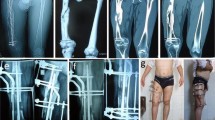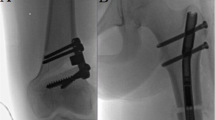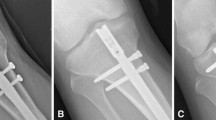Abstract
Background
The Intramedullary Skeletal Kinetic Distractor (ISKD) (Orthofix Inc, Lewisville, TX, USA) is an intramedullary device designed for more comfortable limb lengthening than that with external fixators; lengthening is achieved with this nail using rotational oscillation between two telescoping sections. However, the degree to which this device achieves this goal and its complication rate have not been fully documented.
Questions/purposes
We determined (1) the frequency with which distraction was not achieved at the desired rate, (2) whether pain differed between patients with normally and abnormally distracting nails, (3) risk factors for abnormal nails, and (4) other complications.
Methods
We analyzed 35 lengthening segments (26 femurs, nine tibias) in 19 patients. Mean length achieved was 47 mm. Femoral nails were categorized into four groups according to distraction rate: normal, runaway (unintentionally faster rate [> 1.5 mm/day]), difficult-to-distract (slower rate [< 0.8 mm/day] requiring manual manipulation but not requiring general anesthesia), and nondistracting (slower rate [< 0.8 mm/day] requiring manual manipulation under general anesthesia or reosteotomy). Possible risk factors, including age, BMI, preoperative thigh circumferences, degree of intramedullary overreaming, and length of the thicker portion of the nail within the distal fragment, were compared among groups. VAS pain scores were compared among groups under three conditions: rest, physiotherapy, and distraction motion. Complications were also analyzed. Minimum followup was 15 months (mean, 26 months; range, 15–38 months) after first-stage surgery.
Results
Abnormal distraction rate was observed in 21 of 35 segments (60%; 17 femurs, four tibias). VAS pain scores showed no differences among groups during rest or physiotherapy but were higher (p = 0.02) in the problematic nails (7–8 points) versus normal nails (3 points) during distraction. Only mean length of the thicker portion of the nail within the distal fragment differed between normally and abnormally distracting nails (95 mm versus 100 mm; p = 0.03), although this was unlikely to be clinically important. Complications occurred in 10 patients (53%), including five with decreased ankle ROM during distraction, four with delayed bone healing, and one with mechanical device failure during distraction.
Conclusions
Rate control was difficult to achieve with the ISKD nail for femoral and tibial lengthenings, complications were relatively common, and among patients in whom rate control was not achieved, pain levels were high. Based on our findings, we believe that surgeons should avoid use of this nail.
Level of Evidence
Level IV, therapeutic study. See Instructions for Authors for a complete description of levels of evidence.


Similar content being viewed by others
References
Baumann E, Harms J. [The extension nail: a new method for lengthening of the femur and the tibia] [in German]. Arch Orthop Unfallchirurg. 1997;90:139–146.
Baumgart R, Bets Z, Schweiberer L. A fully implantable motorized intramedullary nail for limb lengthening and bone transport. Clin Orthop Relat Res. 1997;343:135–143.
Bliskonov AI. [Lengthening of the femur using implantable appliances][in Czech]. Acta Chir Orthop Traumatol Cech. 1984;51:454–466.
Burghardt RD, Herzenberg JE, Specht SC, Paley D. Mechanical failure of the Intramedullary Skeletal Kinetic Distractor in limb lengthening. J Bone Joint Surg Br. 2011;93:639–643.
Cole JD, Justin D, Kasparis T, DeVlught D, Knoblocj C. The Intramedullary Skeletal Kinetic Distractor (ISKD): first clinical results of a new intramedullary nail for lengthening of the femur and tibia. Injury. 2001;32:SD129–SD139.
García-Cimbrelo E, Curto de la Mano A, García-Rey E, Cordero J, Marti-Ciruelos R. The intramedullary elongation nail for femoral lengthening. J Bone Joint Surg Br. 2002;84:971–977.
Guichet JM, Casar RS. Mechanical characterization of a totally intramedullary gradual elongation nail. Clin Orthop Relat Res. 1997;337:281–290.
Guichet JM, Deromedis B, Donnan LT, Peretti G, Lascombes P, Bado F. Gradual femoral lengthening with the Albizzia intramedullary nail. J Bone Joint Surg Am. 2003;85:838–848.
Hankemeier S, Pape HC, Gosling T, Hufner T, Richter M, Krettek C. Improved comfort in lower limb lengthening with the intramedullary skeletal kinetic distractor: principles and preliminary clinical experiences. Arch Orthop Trauma Surg. 2004;124:129–133.
Kenawey M, Krettek C, Liodakis E, Meller R, Hankemeier S. Insufficient bone regenerate after intramedullary femoral lengthening: risk factors and classification system. Clin Orthop Relat Res. 2011;469:264–273.
Krieg AH, Speth BM, Foster BK. Leg lengthening with a motorized nail in adolescents: an alternative to external fixators? Clin Orthop Relat Res. 2008;466:189–197.
Kubiak E, Strauss E, Grant A, Feldman D, Egol KA. [Early complications encountered using a self-lengthening intramedullary nail for the correction of limb length inequality][in Turkish]. Joint Dis Relat Surg. 2007;18:52–57.
Mahboubian S, Seah M, Fragomen AT, Rozbruch SR. Femoral lengthening with lengthening over a nail has fewer complications than intramedullary skeletal kinetic distraction. Clin Orthop Relat Res. 2012;470:1221–1231.
Paley D. Problems, obstacles, and complications of limb lengthening by the Ilizarov technique. Clin Orthop Relat Res. 1990;250:81–104.
Schiedel FM, Pip S, Wacker S, Pöpping J, Tretow H, Leidinger B, Rödl R. Intramedullary limb lengthening with the Intramedullary Skeletal Kinetic Distractor in the lower limb. J Bone Joint Surg Br. 2011;93:788–792.
Simpson AH, Shalaby H, Keenan G. Femoral lengthening with the Intramedullary Skeletal Kinetic Distractor. J Bone Joint Surg Br. 2009;91:955–961.
Tjernstrom B, Olerud S, Rehnberg L. Limb lengthening by callus distraction: complications in 53 cases operated 1980–1991. Acta Orthop Scand. 1994;65:447–455.
Wang K, Edwards E. Intramedullary skeletal kinetic distractor in the treatment of leg length discrepancy—a review of 16 cases and analysis of complications. J Orthop Trauma. 2012;26:e138–e144.
Witt AN, Jager M. Results of animal experiments with an implantable femur distractor for operative leg lengthening. Arch Orthop Unfallchir. 1977;88:273–279.
Acknowledgments
The authors thank Dr. Hyun Woo Kim and Dr. Jin Ho Hwang for their valuable advice and fruitful discussions.
Author information
Authors and Affiliations
Corresponding author
Additional information
Each author certifies that he or she, or a member of his or her immediate family, has no commercial associations (eg, consultancies, stock ownership, equity interest, patent/licensing arrangements, etc) that might pose a conflict of interest in connection with the submitted article.
All ICMJE Conflict of Interest Forms for authors and Clinical Orthopaedics and Related Research ® editors and board members are on file with the publication and can be viewed on request.
Clinical Orthopaedics and Related Research ® neither advocates nor endorses the use of any treatment, drug, or device. Readers are encouraged to always seek additional information, including FDA approval status, of any drug or device before clinical use.
Each author certifies that his or her institution approved the human protocol for this investigation that all investigations were conducted in conformity with ethical principles of research, and that the informed consent for participation in the study was obtained.
This work was performed at CHA Bundang Medical Center, Kyungki-do, Republic of Korea.
About this article
Cite this article
Lee, D.H., Ryu, K.J., Song, H.R. et al. Complications of the Intramedullary Skeletal Kinetic Distractor (ISKD) in Distraction Osteogenesis. Clin Orthop Relat Res 472, 3852–3859 (2014). https://doi.org/10.1007/s11999-014-3547-4
Published:
Issue Date:
DOI: https://doi.org/10.1007/s11999-014-3547-4




